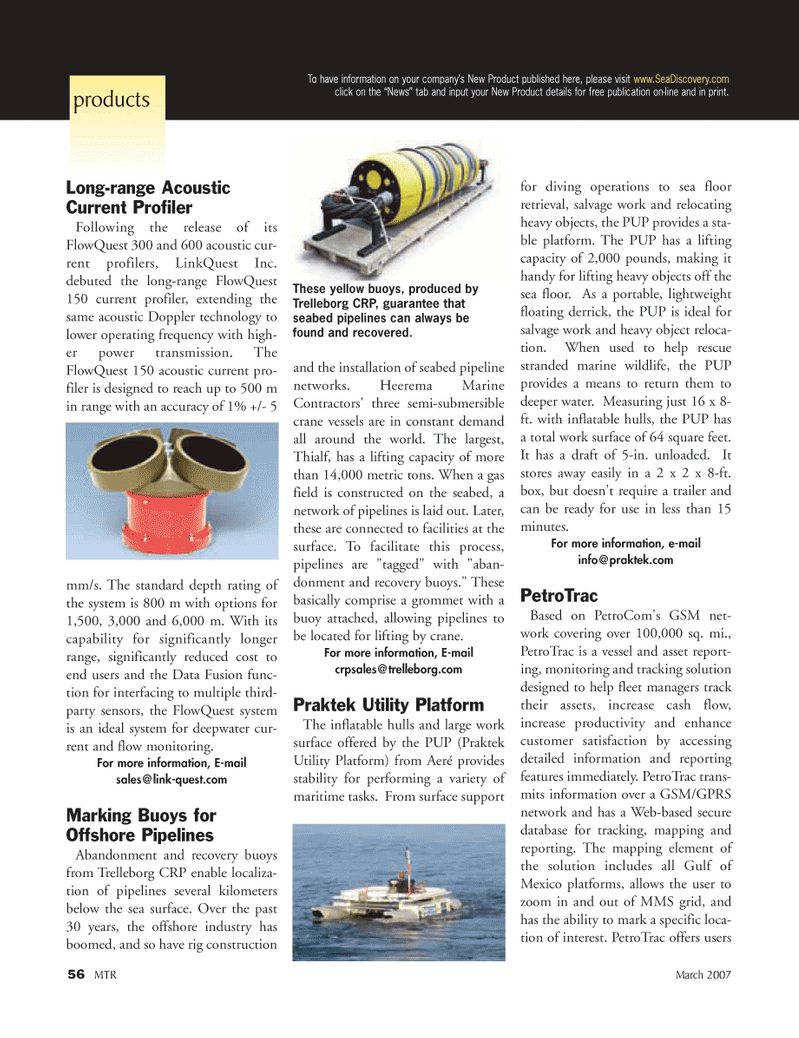
Page 56: of Marine Technology Magazine (March 2007)
AUVs, ROVs, UUVs
Read this page in Pdf, Flash or Html5 edition of March 2007 Marine Technology Magazine
56 MTR March 2007
Long-range Acoustic
Current Profiler
Following the release of its
FlowQuest 300 and 600 acoustic cur- rent profilers, LinkQuest Inc. debuted the long-range FlowQuest 150 current profiler, extending the same acoustic Doppler technology to lower operating frequency with high- er power transmission. The
FlowQuest 150 acoustic current pro- filer is designed to reach up to 500 m in range with an accuracy of 1% +/- 5 mm/s. The standard depth rating of the system is 800 m with options for 1,500, 3,000 and 6,000 m. With its capability for significantly longer range, significantly reduced cost to end users and the Data Fusion func- tion for interfacing to multiple third- party sensors, the FlowQuest system is an ideal system for deepwater cur- rent and flow monitoring.
For more information, E-mail [email protected]
Marking Buoys for
Offshore Pipelines
Abandonment and recovery buoys from Trelleborg CRP enable localiza- tion of pipelines several kilometers below the sea surface. Over the past 30 years, the offshore industry has boomed, and so have rig construction and the installation of seabed pipeline networks. Heerema Marine
Contractors' three semi-submersible crane vessels are in constant demand all around the world. The largest,
Thialf, has a lifting capacity of more than 14,000 metric tons. When a gas field is constructed on the seabed, a network of pipelines is laid out. Later, these are connected to facilities at the surface. To facilitate this process, pipelines are "tagged" with "aban- donment and recovery buoys." These basically comprise a grommet with a buoy attached, allowing pipelines to be located for lifting by crane.
For more information, E-mail [email protected]
Praktek Utility Platform
The inflatable hulls and large work surface offered by the PUP (Praktek
Utility Platform) from Aeré provides stability for performing a variety of maritime tasks. From surface support for diving operations to sea floor retrieval, salvage work and relocating heavy objects, the PUP provides a sta- ble platform. The PUP has a lifting capacity of 2,000 pounds, making it handy for lifting heavy objects off the sea floor. As a portable, lightweight floating derrick, the PUP is ideal for salvage work and heavy object reloca- tion. When used to help rescue stranded marine wildlife, the PUP provides a means to return them to deeper water. Measuring just 16 x 8- ft. with inflatable hulls, the PUP has a total work surface of 64 square feet.
It has a draft of 5-in. unloaded. It stores away easily in a 2 x 2 x 8-ft. box, but doesn't require a trailer and can be ready for use in less than 15 minutes.
For more information, e-mail [email protected]
PetroTrac
Based on PetroCom's GSM net- work covering over 100,000 sq. mi.,
PetroTrac is a vessel and asset report- ing, monitoring and tracking solution designed to help fleet managers track their assets, increase cash flow, increase productivity and enhance customer satisfaction by accessing detailed information and reporting features immediately. PetroTrac trans- mits information over a GSM/GPRS network and has a Web-based secure database for tracking, mapping and reporting. The mapping element of the solution includes all Gulf of
Mexico platforms, allows the user to zoom in and out of MMS grid, and has the ability to mark a specific loca- tion of interest. PetroTrac offers users
These yellow buoys, produced by
Trelleborg CRP, guarantee that seabed pipelines can always be found and recovered. products
To have information on your company’s New Product published here, please visit www.SeaDiscovery.com click on the “News” tab and input your New Product details for free publication on-line and in print.
MTR#2 (49-64).qxd 3/1/2007 10:36 AM Page 56

 55
55

 57
57
